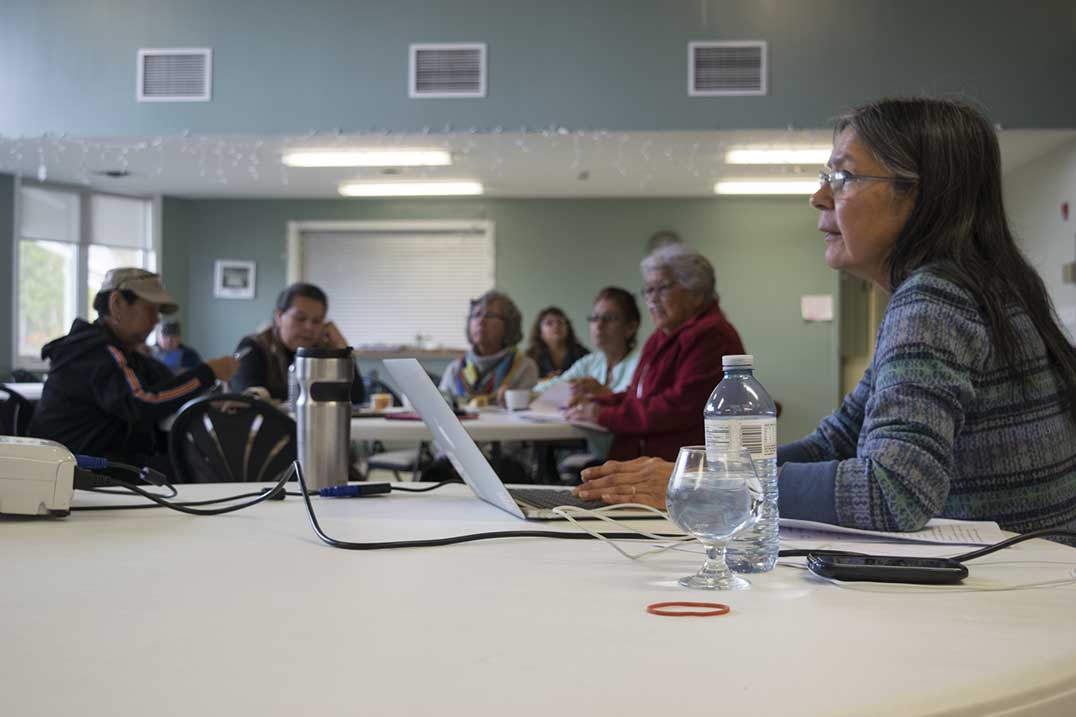Program encourages community elders to speak their language, regardless of apprehension
by Gina Gasongi Simon
M’CHIGEENG—The motto ‘build it and they shall come’ has been just that for the M’Chigeeng First Nation elders that have been the host and mentors of the Bizindaadiwag Miinwaa Ganoonnidiwag Project. The purpose of the project was for fluent speakers to mentor and coach the learners of Anishinaabemowin. The final celebration of the project, which began in March 2018, was hosted in their building, called Anishinaabemowin Gamig on September 29.
The elders and project participants played host to an audience of community members and held true to Anishinaabemowin Gamig’s vision, which is to improve the quality of life for elders through inclusion and by providing the elders with a sense of purpose. The Bizindaadiwag Miinwaa Ganoonnidiwag project coincides with the by engagement of elders in healthy social activities and utilizing their skills and knowledge of traditions and the Anishinaabe language.
The program was designed with the masters of the language, Anishinaabemjig, leading the master apprentices, Shki-Anishinaabemjig, through various activities and projects. The ultimate goal was to assist the apprentices with a better understanding and confidence to speak, work and develop their vocabulary and pride in Anishinaabemowin.
Ojibwe—otherwise anglicized as Chippewa, Ojibwa or Ojibway and known to its own speakers as Anishinaabe or Anishinaabemowin—is an Algonquian language spoken by approximately 50,000 people in the northern United States and southern Canada.
The Bizindaadiwag Miinwaa Ganoonnidiwag project was made possible with the effort of elders Gene Bebamash, Perry Bebamash, Caroline Corbiere, Ted Corbiere, Nancy Debassige, Alma Jean Migwans, Evelyn Roy, Eileen Simon and Michael Wassegijig. Each dedicated time and effort to teach the language through various learning activities.
Many games, crafts and outdoor activities were utilized as teaching tools and proved different methods can bring about new positive results. For instance, the auctions allowed participants to learn common household goods and practice the new words. Spoons and Stomps was another game based on active listening and speaking practices. Flute making and flower arrangement assisted with the use of action words and identifying tools required to complete their projects.
Other activities included: human anatomy, outdoor cooking and shopping, all intended to encourage daily conversation on local landscape, current local and community events.

photo by Warren Schlote
The teaching by the master language speakers was conducted on a one-to-one coaching basis or in one of the popular group settings. A mapmaking project was enjoyed by the Shki-Anishinaabemjig and master apprentices Bonita Bebamash, Dora Bebamash, Eria Bebonang, Amy Debassige, Pina Hare, Francine Mendoshkin and Sheldon Migwans. This historical rejuvenating activity provided an opportunity for the participants to recall places, family names, local customs and reminiscence about elders that influenced their lives and those of the community.
Another highlight for the final day of celebration was the presence of Mary Ann Corbiere, an associate professor at the Department of Indigenous Studies, University of Sudbury. The invited lecture by Ms. Corbiere was well received and drummed up plenty of discussion as she shared the developments of her Anishinaabemowin dictionary and presented various forms and schools of Anishinaabemowin writing systems. The discussion drew a variety of responses as participants expressed their concerns about loss of language; who is sanctioned to write and document the Anishinaabe language; what is the right system to use when writing the language; understanding proper use of verbs and pronouns, right down to the emotional fear of sounding silly when learners attempt to speak the language.
Ms. Corbiere stated clearly, “In my findings and research, no current and past writing system can claim to be the right one. There currently exists many writing systems, like the Rhodes, Wilson and Ojibwe People’s Dictionary. The point is they have all done their part to document the language; they do exist, however correct or incorrect they are in their current state.”
Her proposal while she continues to work on her Anishinaabemowin dictionary is to invite those knowledgeable about the language to add their understanding of how words and phrases should or could be written. “Each place like M’Chigeeng, Sagamok or Wiikwemkoong will have a slight variation on how a particular word is pronounced. I am not going to stand before you and say one is right over the other, nor would I declare which spelling utilizing the English alphabet is correct.”
However, she did emphasize the need to develop a standard of writing. Her belief is based upon the more you provide, the more readily the information will be accessed and become common knowledge.
“If we take, for instance, Harry Potter, everyone seems to know or have heard of Harry Potter because the story and topic is so widely distributed and talked about.” Ms. Corbiere has gathered thousands of words for her online dictionary and continues to make entries on a daily and weekly basis. She tries to provide as many examples as possible to show the learner. “There does exist different ways to enunciate words and depending on the community you reside in, you may learn a slight variation‚” she explained.
After much discussion on how to say words and examples of writing it was agreed when comparing the ‘English way,’ to accent certain syllables, is many times in contrast to Anishinaabemowin accentuation. “Even in the English language, words are not always pronounced the exact same way; this is true for our language. Understanding the vowels and verbs are very difficult for those learning our language. The silent sounds, the more guttural are hard to differentiate for most beginners. Sounds that are understood by seasoned speakers of our language and complicated for those trying to write what they have heard using the English alphabet‚” said Ms. Corbiere.
“What we do need is a standard upon which we can agree to write and document the language. Why reinvent the wheel? Let’s build on it and work towards making it better for the learner‚” she stated.
For the final portion of the day, those gathered witnessed the development of a skit entitled, ‘Ko Ko Ko Minwaa Nanabozhoo.’ presented entirely in Anishinaabemowin. It told a story about famine and its ill effects on a community. The skit relayed the story about how Nanabozhoo gathered the council of animals, doodemwin, to help him teach the owl a lesson about sickness. Sheltered by a beautiful backdrop of homemade props and costumes, Nanabozhoo and Ko Ko Ko duel it out in a battle of trickery and games. Through the use of songs and dance, Nanabozhoo tricks the owl and returns the community back to a healthy state.
To include those who did not have the opportunity to participate, a slideshow was presented highlighting participants and some of the project’s accomplishments, followed by a delicious full course meal and topped with the most amazing desert. Flowers and congratulatory speeches were made by Grace Fox to all those who helped make the project a success.
The Bizindaadiwag Miinwaa Ganoonnidiwag project has been supported by M’Chigeeng First Nation which passed a band council resolution in support of any efforts to instil and promote the Anishinaabe language along with the Aboriginal Languages initiative, the Aboriginal People’s Program of the Department of Canadian Heritage.
The overall general group consensus was reflected in Elder Gene Bebamash’s words: “It doesn’t end here, I will continue to host gatherings at my home with those that wish to continue learning and sharing in Anishinaabemowin.”
All the project participants wish to express their gratitude to the Anishinaabemowin Gamig Steering Committee, Grace Fox, Elaine Debassige, Pauline Debassige and Roseann Debassige for their for support and dedication to the project.





